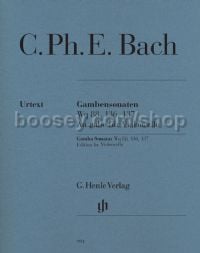Gamba Sonatas Wq 88, 136, 137 - Cello Edition
Gamba Sonatas Wq 88, 136, 137 - Cello Edition
* Estimated price converted from UK retail price
Urtext Edition, Edition for Violoncello and Harpsichord, paperbound with marked and unmarked string parts.
Like his father, Carl Philipp Emanuel Bach wrote three sonatas for viola da gamba. They were written during his time at the Berlin court of Frederick the Great and gave the excellent viola da gamba player in the court orchestra a chance to show his virtuosic skills. While the two Sonatas Wq 136 and 137 have a basso continuo, Bach followed his father’s example as far as the Sonata in g minor Wq 88 was concerned: the right and left hands of the harpsichord compete with the solo instrument in three equal parts. These sonatas can also be played very effectively on the cello; the fingerings in the marked copies provide helpful suggestions.
Preface
The extensive chamber-musical oeuvre of Carl Philipp Emanuel Bach (1714– 88) also contains three sonatas for viola da gamba and harpsichord. Bach’s father Johann Sebastian had also produced three works in this scoring, the well-known Gamba Sonatas BWV 1027–29. But whereas they represent the obbligato type (i. e. the melody instrument and the harpsichord’s upper and lower parts in an even, three-part texture), C. P. E. Bach’s first two Gamba Sonatas, the early works Wq 136 and 137, were written for viola da gamba and basso continuo; the solo instrument predominates and is accompanied by the chords of the harpsichord. Only in the later g-minor Sonata Wq 88 did Carl Philipp Emanuel follow his father’s structural model. Consequently, one generally encounters the designation “Trio” here (which is already present in the wording of the autograph’s title), which takes the three-part texture into account.
The structural differences among Carl Philipp Emanuel’s sonatas also become evident through their position in the Verzeichniß des musikalischen Nachlasses des verstorbenen Capellmeisters Carl Philipp Emanuel Bach (Hamburg, 1790, reprinted as The Catalog of Carl Philipp Emanuel Bach’s estate, New York, 1981). The Sonatas Wq 136 and 137 are listed in the category “Solos for other instruments than the keyboard” (p. 50): Wq 136 as “No. 11. B[erlin]. 1745, for the flute [recte: Viol di Gambe]”, and Wq 137 as “No. 12. B[erlin]. 1746, for the Viol di Gambe”. Conversely, the Sonata Wq 88 is found under the rubric “Trios” (p. 40) as “No. 25 B[erlin]. 1759. Clavier and Gamba“.
The two Sonatas Wq 136 and 137, each written at about the same time, survive in copies of the score (located today in the Conservatoire royal, Brussels) from the estate of the Schwerin organist Johann Jacob Heinrich Westphal (1756–1825). One of the leading collectors of the works of Carl Philipp Emanuel Bach, Westphal had contacted Bach in the last years of the composer’s life in order to complete his collection. Bach regularly sent him copies of his works and, in his correspondence, also mentioned some (not more closely specified) “Soli”. As is the case in the Nachlassverzeichnis (Catalogue of Bach’s estate), this term might also include the Sonatas Wq 136 and 137, which would suggest that a copy had been made during Bach’s lifetime. However, Westphal also continued to receive copies after Bach’s death through his widow Johanna Maria (1724–95) and their daughter Anna Carolina Philippina Bach (1747– 1804). A letter written by Anna Carolina to Westphal in 1791, in which she points out the faulty scoring indication (flute instead of gamba) of the Sonata Wq 136 in the Nachlassverzeichnis, suggests that Westphal was not yet in possession of at least this Gamba Sonata at that time. The copy of Wq 136 was made by Ludwig August Christoph Hopff (1715–98), a viola player who lived in Hamburg and was active as a copyist for C. P. E. Bach and, after his death, for Bach’s widow and daughter. Wq 137 was copied by Johann Heinrich Michel (1739–1810), one of Bach’s two principal copyists in Hamburg.
The editors are grateful to the libraries listed in the Comments for kindly putting copies of the sources at their disposal. They also extend their cordial thanks to gamba player Thomas Fritzsch (Freyburg/ Unstrut) for his enlightening information concerning the gamba.
Leipzig · Munich, autumn 2011 - Wolfram Enßlin & Ernst-Günter Heinemann




